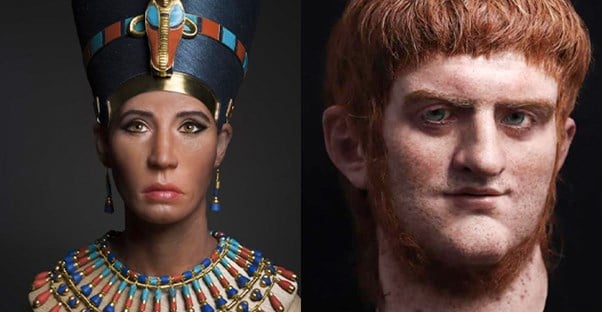George Washington

Everyone knows George Washington and his accomplishments as the first president of the United States. Most of the images we see of him show him with a stern brow and a strong jawline, which is pretty typical for the time – just take a look at any picture of Benjamin Franklin.
George Washington was America’s first president. He set the precedent for American leadership for generations to come. Of course, he and his cohorts at the time would want his likeness remembered as strong, stern and overall, not ugly! The facial features given to him for at the time of the painting’s rendering were seen as desirable and attractive.
George Washington

A recreation of his appearance shows something similar to what we’ve seen in our textbooks. There are a few differences, however. First, his nose was slightly more hooked than what we’ve seen in paintings. Additionally, his jaw is much stronger and even has a few dimples to accompany those red cheeks.
This recreation brings life to the face we’ve seen in Americana for decades. The stern look in his eyes show he was a force of nature not to be taken lightly. While his pictures seem so detached from what people in our day in age look like, this recreation probably may even look like someone you know. Afterall, he was a person just like you!
King Tutankhamun

King Tut is most famous for his opulent tomb, which was disturbed and cursed those who found it (supposedly). After it was discovered, we all got a good look at the mask of King Tut, which showed the young prince for the first time. It was the only real image we’ve been able to pull from for ages.
(Image via Pinterest; Facebook)
What King Tutankhamun actually looks like has been a major mystery in Egyptology. It was only recently that we really understood his true age. Also, several people theorize that the boy king actually had several physical deformities related to inbreeding in the Egyptian royal bloodline, hence his death at an early age.
King Tutankhamun

Like many of these masks, it didn’t quite tell the whole story. King Tut was a pretty ill. Historians believe that he had a club foot (for which he owned several canes), an overbite, and wide hips. When his mouth was open, his teeth were likely buckteeth. He also had a flat head, a trend that was common during this time.
(Image via Pinterest; Pinterest)
It’s hard to believe that one of the most revered and honored kings in Egyptian history was sickly small young man. However, his stature and legacy tower among others for his time as ruler of ancient Egypt. He’s probably one of the most discussed and remembered pharos of his culture, a goal many sought to achieve.
Cleopatra

Cleopatra often referred to herself as Isis, so it makes sense that many people would consider her beautiful. On top of that, she was also incredibly intelligent, having known nine languages and being the first Pharaoh to make Egyptian the official language despite herself being Greek.
(Image via Pinterest; Wikipedia)
She must have been beautiful, considering she wooed both Julius Caesar and Mark Antony. She must have been beautiful, considering she wooed both Julius Caesar and Mark Antony. Most people would be shocked to know that Cleopatra was actually a Greek woman who possessed traditionally Greek features. Her image can be seen on coins all over the fertile crescent.
Cleopatra
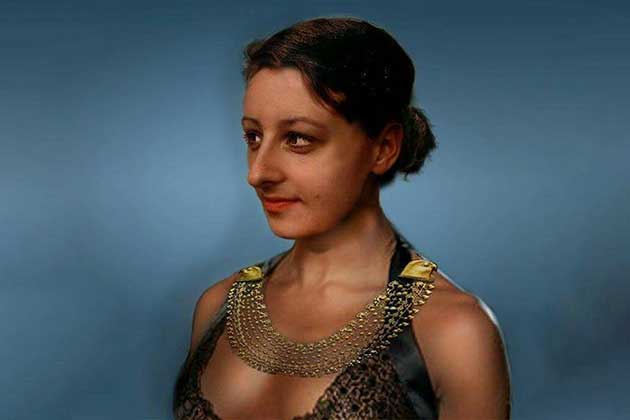
Cleopatra's beauty inspired countless works of art, but she wasn’t the beauty many of us have seen. Okay, well, that isn’t fair. She’s still quite beautiful, and it’s easy to see why so many men fell for her. However, it’s obvious that this isn’t the woman we’ve seen for decades.
Much of her appeal came from her intelligence, which is pretty understandable considering how fiercely she ruled. She had a traditional Greek large nose which her paintings and busts conveniently scaled down. However, we’re here to say Greek noses are beautiful and should have been on her images from the get-go.
Roman Emperor Nero

Nero has an infamous reputation for being one of the evilest men in history. He’s so terrible that ancient historians and scholars state that he started the great fire that destroyed Rome in 64 A.D. Busts of the evil Nero are pretty accurate, but Nero had very masculine features to begin with – something that’s often added to busts to appear stronger as a ruler.
(Image via Wikipedia; Wikipedia)
It's said that Nero danced and fiddled on the roof while his empire burned to the ground. Clearly through the ages the tale has been added on to and exaggerated and added on to, but his reputation does go down in history as one of the most evil people in Rome.
Roman Emperor Nero

While the busts are pretty accurate, there’s something not many of us saw coming – red hair. That’s right! Nero had flaming red hair (no pun intended) and freckles. He doesn’t look like what many of us thought, mostly since modern citizens of Rome look much different.
Maybe the story of Rome going down in flames was a euphemism for Nero’s flaming red hair. Considering he was a controversial person for the time period, grand tales of people’s distaste for him must have been told in a subversive way. Who says the ancients weren’t smart? Now we all know Nero for who he was!
Nefertiti
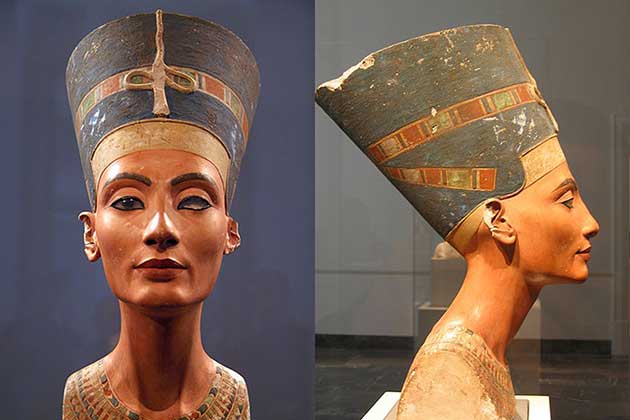
Nefertiti was rumored to be the most beautiful woman in Egypt during the 14th century B.C. While many people know her name, they may not know that she was the wife of Pharaoh Akhenaten (and later mother to King Tut). Even her name meant, “the beautiful one has come.”
(Image via Wikipedia; Wikipedia)
The two were certainly a power couple, even creating their own religion, the cult of Aten. Sculptures in her image feature high cheekbones, symmetrical lips and an elegant jawline. These days, those sculpted features sitting on a long slender neck would win her a spot on the world’s most prominent runways. Her features were shown as near perfect. She must have really made a lasting impression on her subjects.
Nefertiti

Nefertiti is often depicted with a Pharaoh’s headdress as she had more power than previous wives. Then, in 2018, a team at the University of Bristol released this bust, using a mummy that’s believed to be Nefertiti’s. While there’s controversy over her skin color, it’s believed her bone structure is pretty accurate.
The supposedly accurate depiction of Queen Nefertiti on this bust still shows elegant features that would have caught the eyes of people in her time of rule. The symmetrical structure of her face shows that she was a beauty for the history books. Adorned with lavish jewels and dress, she truly was a queen.
Mary Queen of Scots

Mary Queen of Scots became queen when she was just six days old but was shipped to France for an education. By 19, she would return to Scotland to take over the role of queen. She was known for her unparalleled beauty and physical stature – standing 5'11". Since she was Queen Elizabeth I cousin, the two looked very similar.
Her red hair and fair skin was considered highly attractive in her time. Being 5’11 also placed her head and shoulders above the rest of her peers. Truly, she must have been a presence in a room. Not only was she royal, but her pictures show her to be extremely beautiful.
Mary Queen of Scots

Mary's true face was reconstructed, and she certainly looks different. The years of her tumultuous life (mostly imprisonment) obviously took a major toll on her, as her reconstruction shows an older face. That being said, she's still quite beautiful. It turns out the paintings weren’t too far off, although they did still have the typical de-aging thing going on.
The general features of her face are the same, but just like today you can’t always trust what you see in pictures. People will always depict themselves positively, and when you’re a queen like Mary Queen of Scots, you would definitely have your painting commissioned with a friendly hand. Who wouldn’t want to put their best foot forward when being remembered in history.
Julius Caesar

Julius Caesar was a Roman statesman and general who played an immensely important role in the rise of the Roman Empire. Accounts claim that he was a slim, thin-haired man, who often has a very discerning brow. Most depictions show him as an older man, which isn’t too odd, considering he didn’t rule very long.
(Image via Pinterest; Pinterest)
Julius Caesar is always shown with a look of skepticism. We don’t blame him for it either, considering how his death played out. Everyone he ever knew came together to bring his demise. Uniquely he was shown with signs of aging in his depictions, revealing his discerning mature look forever.
Julius Caesar

Recent reconstructions show him looking a little different, although with very similar features. While he still has the stern brow, his head looks…much different. We have to point it out. Archaeologist Tom Buijtendorp claimed the head was misshapen due to a “heavy delivery.” Another thing we noticed: his eyes are super close together.
Let’s just break down a few things here. While his depictions show a mature man with a strong stature, this life-like rendering is nothing like his historical imagery. At least the statues showcased his unique head shape, but the sculptor conveniently left out the fact that Caesar had the peripheral vison of a marlin.
Jesus of Nazareth

Most of us saw images of Jesus since we were young children, and most renditions are the same. He’s a younger to middle-aged man, usually light-skinned. He also often has long, light brown, wavy hair and a longer beard. Sometimes, he even has blue eyes. Historians and artists got together to create an image of what Jesus would really look like.
Christianity was widely adopted by the Romans and Greeks, eventually evolving into Catholicism. It’s likely that a poor understanding of the world outside of their cities led them to depict Jesus of Nazareth like them, especially since travel wasn’t necessarily a thing back then. Regardless of how you feel about it, Jesus was not a white man.
Jesus of Nazareth

The real image of Jesus looks much different. Real scholars determined that Jesus would have a darker hue, like many other people in Israel at the time. Along with this, his hair was likely a woolly texture and dark brown in color. Finally, his eyes would most certainly be brown.
We hate to break it to you but that blonde hair, blue eyed, Obi Wan Kenobi picture you’ve been staring at on your grandma’s wall for the past years isn’t what the son of the almighty likely looked like. It’s just not feasible with his geographical location and time period.
Queen Elizabeth I

Queen Elizabeth I was one of the most famous monarchs in British history. She’s also famous for being one of the most beautiful queens, one that was eternally youthful. Well, there’s a reason for that – Queen Elizabeth was extremely concerned about her appearance. When she got older, she issued a “face template” for artists to work off of. This is why many of the portraits look alike.
(Image via Wikipedia; Wikipedia)
She wanted her visage to be permanently youthful, and honestly, we don’t blame her. Back then there wasn’t anything you could do besides visiting your local forest witch to ward off aging. We could imagine that the queen was totally beautiful in her younger years, and while the portraits were painted from a template, it’s still her nonetheless.
Queen Elizabeth I

The real Elizabeth obviously aged, and her beauty techniques took a huge toll on her skin. Pale skin was sought-after, so many women often painted their faces with white paint. The white paint Elizabeth used (along with many other women) was heavy with lead. Lead, which is toxic to the skin, severely damaged her skin. She also contracted smallpox, which left her half-bald and skin pocked.
(Image via WikiCommons; Smithsonian)
If Queen Elizabeth I was around today you could bet your bacon she would be in the company of fashionistas like Anna Wintour. Her day in age was a rough one to live through. Ravaged with disease, bad medical practices and who knows what else. Despite the lead poisoning and pox, she was still beautiful for her age.
William Shakespeare
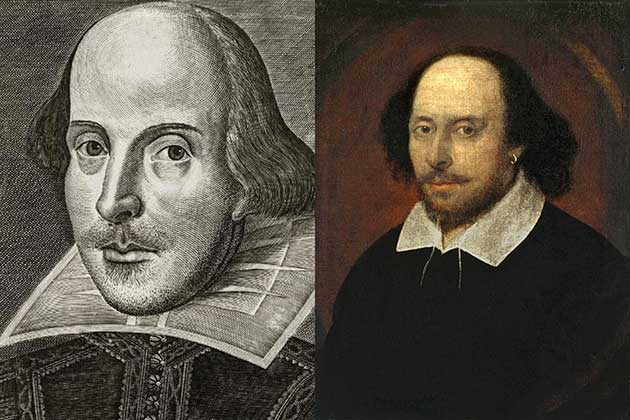
Even though Shakespeare is more recent than many entries on this list, his appearance still changes quite a bit from artist to artist. Most portraits show him with dark brown (or sometimes reddish) hair that goes down to his shoulders, although his head is bald. The pictures also often show a face that’s smoother than a baby’s bottom.
(Image via Wikipedia; Pinterest)
William Shakespeare was a legendary literary genius that earned his place in history. His scripts told compelling stories that pulled heart strings and raised eyebrows for centuries. It’s not wonder his portraits were painted with such careful consideration for his looks, he was probably a fun guy to be around!
William Shakespeare

Recent images of Shakespeare’s real appearance were created using his death mask. The mask shows that he clearly had a bald head. What really changes is his skin texture. It was damaged from years in the sun and became wrinkled with age. He also had a much thicker nose than is depicted on most artist renditions.
(Image via Facebook; Facebook)
In fairness though, this was the poor man’s death mask. Everyone who’s on the brink of death is going to look a little raggedy. While there were facial structure differences, we’d say his portraits weren’t too far off. Maybe he did have more hair when he was younger. Most men do lose their hair later in life, or maybe he was just trying on the bald look.
Dante Alighieri
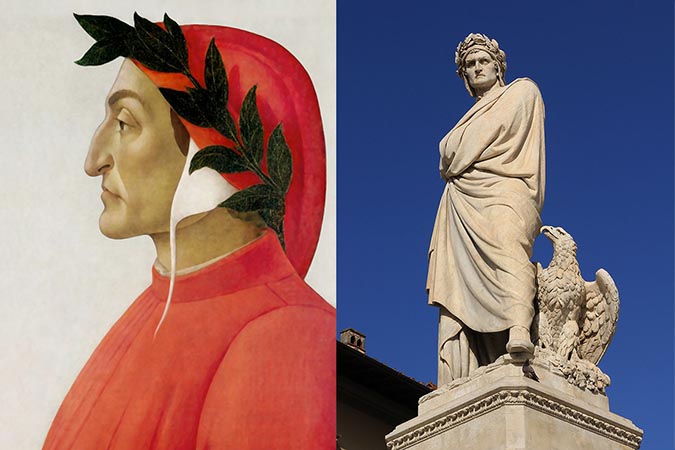
Dante Alighieri is the author of the Divine Comedy, the three-part series about a man making his way through hell (Inferno), purgatory (Purgatorio), and heaven (Paradiso). Dante Alighieri most often is depicted with strong features, particularly a hook nose. The hook nose was depicted to be a “wise” feature.
(Image via Wikipedia; Wikipedia)
Dante’s divine comedy went on to define imagery for the afterlife for entire civilizations of people. Much of our concept of heaven and hell comes from Dante Alighieri. The depiction of fire and brimstone and a fork tongued Satan comes directly from Dante’s imagination. Needless to say, he made an impact.
Dante Alighieri

Because the nose is cartilage (and doesn't stick around long after we pass), we can't prove that Dante didn't have a hook nose, so the facial reconstruction also includes a similar nose. That being said, his features were a lot less sharp than paintings made us think. One big change is his brow, which is much less stern than any painting or statue may show.
Different from the strong and stern features of Dante’s portraits, his features in this recreation is a lot more humble. He does look like he could tell a good story, however hopefully posters weren’t a thing back then because no one would recognize him as the star! Talk about a catfish.
Johann Sebastian Bach
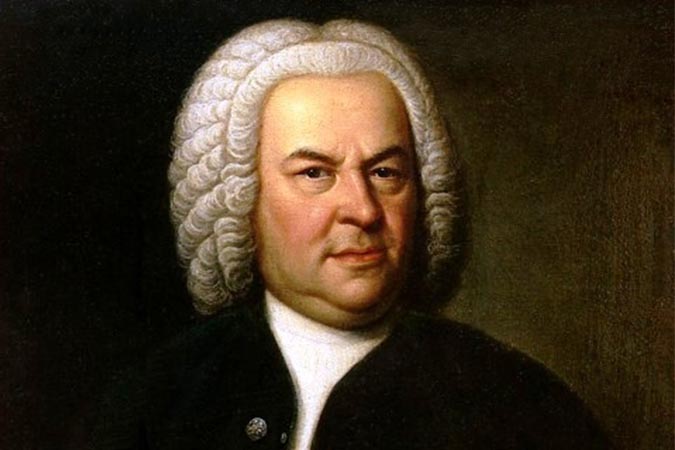
Unlike Mozart and other famous composers, Bach’s life is shrouded in mystery. Bach only sat for a single painting in his lifetime, and that’s the one we used to match a name to a face. So, suffice to say, we don’t have a really good clue of what he looks like – other than the painting, of course.
His body was also buried in an unmarked grave, so it took a while before archaeologists found it. The portrait shows Bach with a glaring look in his eyes and traditionally male features. He looks a little overweight from what we can see. Otherwise, he just looks like someone’s step dad.
Johann Sebastian Bach

Once the grave was found, we could figure out what he really looked like with a little reconstruction. Using the skull, scientists designed an image to show us his real appearance. It doesn't look too much different from what we've seen in the paintings, although there are some major changes. He had a thick neck, a firm brow, and a soft underbite. Stuff like skin and eye color were assumed based on paintings.
From what we see in these two renditions, the nose, eyelids, and cheeks seem pretty similar to his portraits. It’s hard to recreate someone’s facial nuances like an artist could while painting a live person. However, good on them for getting it mostly right. With the same wig and pose, this would totally be Bach!
St. Nicholas
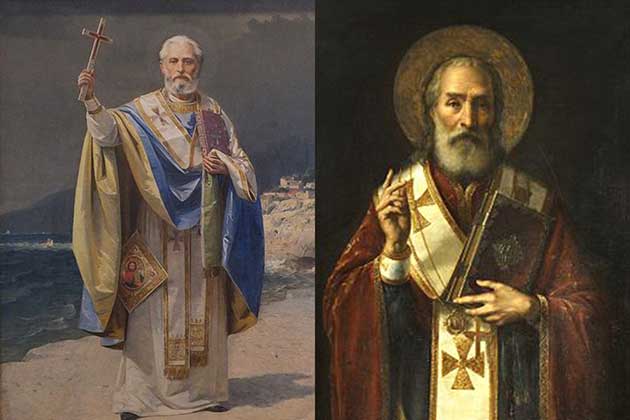
Santa Claus, the holly-jolly giver-of-presents, was based on St. Nicholas. He was born in a small town in the country known as Turkey. Also known as the Patron of Children, St. Nicholas looks just like Santa – Caucasian with hair as white as snow. Well, he actually looks a little different.
(Image via Wikipedia; Wikipedia)
In these depictions he’s shown as a slender man with white hair and beard. For being the saint of children, he looks a little scary serious though. Not the holly jolly Santa Clause we’re used to seeing around the holidays. He was a saint though, so maybe this is more accurate than the Coca-Cola Santa?
St. Nicholas

While he did certainly have snow-white hair as he aged, he looked more like an aged man that had been through a lot of turmoil. He had a heavy jaw and a broken nose that never quite healed properly straight. Many historians believe this was caused when he was imprisoned.
He also had darker skin and brown eyes, something that’s rarely (if ever) depicted in artists’ renditions. Santa is usually depicted as a heavy-set European man with white hair and blue eyes. Sorry to say it, but St. Nicholas probably looked more like Danny Trejo than we would like to think.
Copernicus

Copernicus is the brilliant astronomer who suggested that the Earth actually revolves around the Sun and that the Sun was the center of the Universe (rather than the other way around). His images mostly show that he's a young but masculine guy with a nice mane of thick black hair.
He’s got what seems to be a bit of a crooked nose. His features are definitely exaggerated. He has tiny round eyes and a very prominent chin. Hopefully the artist got a few things off scale because it would be hard to fathom such large features on a face. However, despite the odd features, his hair is nice!
Copernicus
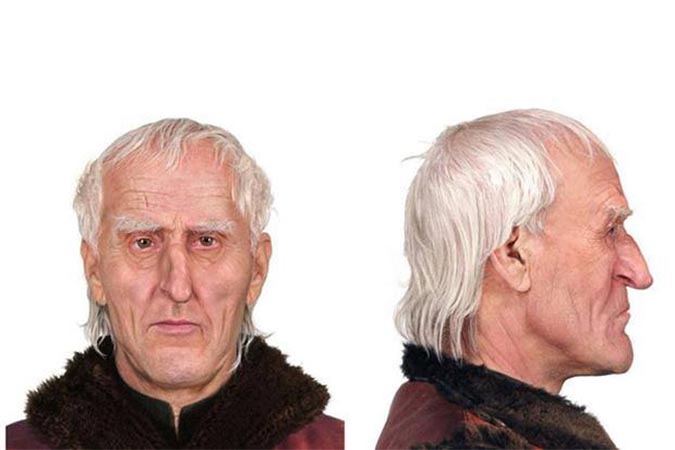
No doubt Copernicus was once a young man with a full thick head of hair at some point in his life, but this scientific facial reconstruction shows an older astronomer. Researchers know for a fact that Copernicus had a broken nose that never healed correctly and a scar above his right eye.
Some have stated that he doesn’t look too unlike modern-day actor James Cromwell. He still has those strong features, however the scale of them makes a lot more sense in this rendition than the previous portrait. We’re sure he was known for that crooked nose and jutting chin. No wonder people thought he was a mad scientist!
Saint Anthony

Saint Anthony is known for being one of the fastest people canonized to sainthood, which occurred a year after his death. Now, he's referred to as the Saint of Lost Things, which comes from the history of his life. Most images show him as a younger man with very soft features.
This image shows Saint Anthony as a smooth faced young man with wide set eyes and wide cheekbones. Possessing almost feminine features, his button nose and almond eyes paint him to be a kind and caring person. His fair skin looks soft and smooth. It would be hard to believe anyone alive during his time had the skincare routine to achieve this!
Saint Anthony

Saint Anthony's actual features look a lot different. First of all, his bowl cut was much less precise, which makes sense since they didn't exactly have clippers. Saint Anthony also had thicker features, from a stronger jawline to a girthy neck While the picture showed him to be a soft young man, they did get a few things correct.
His eyebrows and eyes are a wide set, moon shape. He also did actually have a button nose with cupid’s bow lips. His skin color was likely much darker than what was shown in his depiction. All in all, while similar, Saint Anthony was much more manly than shown in his portrait.
Richard III

Richard III was King of England and Lord of Ireland, and he was one brutal guy. He's best known for his two turbulent years of ruling, which included murdering his nephews (along with anyone else) who threatened to take his throne. Richard's facial features show narrower eyes but soft features.
Most paintings show him with a frown or a straight-lined mouth. His depictions show him throwing daggers from his eyes. We’re sure his skin was fair, considering his geographic location. Most facial features in this portrait seem typically European so we’re betting it’s pretty similar to how he looked in real life.
Richard III

While the paintings show a softer face, they don't show the real Richard. This true to life facial reconstruction taken from Richard III's skull shows he had almost a boy-like face. Now that isn’t the image that comes to mind when you think of this child-killing, brutal leader.
(Image via Facebook; Facebook)
If you’ve ever watched “Shrek” you may think this guy looks a little familiar, that’s because the tiny tyrant Lord Farquaad was totally based on Richard III. Unfortunately, we’re quite certain this isn’t the legacy he would have wanted for himself, but hey you take what you can get, right?
Thomas Jefferson

In school, we become very accustomed to Thomas Jefferson's face. He's just as famous as the first President of the United States, and that reputation only increased after the release of Hamilton. Still, let's not look past his biggest accomplishments. We're talking about the man that helped draft the Declaration of Independence!
Jefferson is also the man who drafted the Virginia Statute for Religious Freedom, which disestablished the Church of England in Virginia – a huge step toward recognizing America as its own country following the Revolution. Basically, when Jefferson got busy, he got busy and didn't stop until the deed was done.
Thomas Jefferson
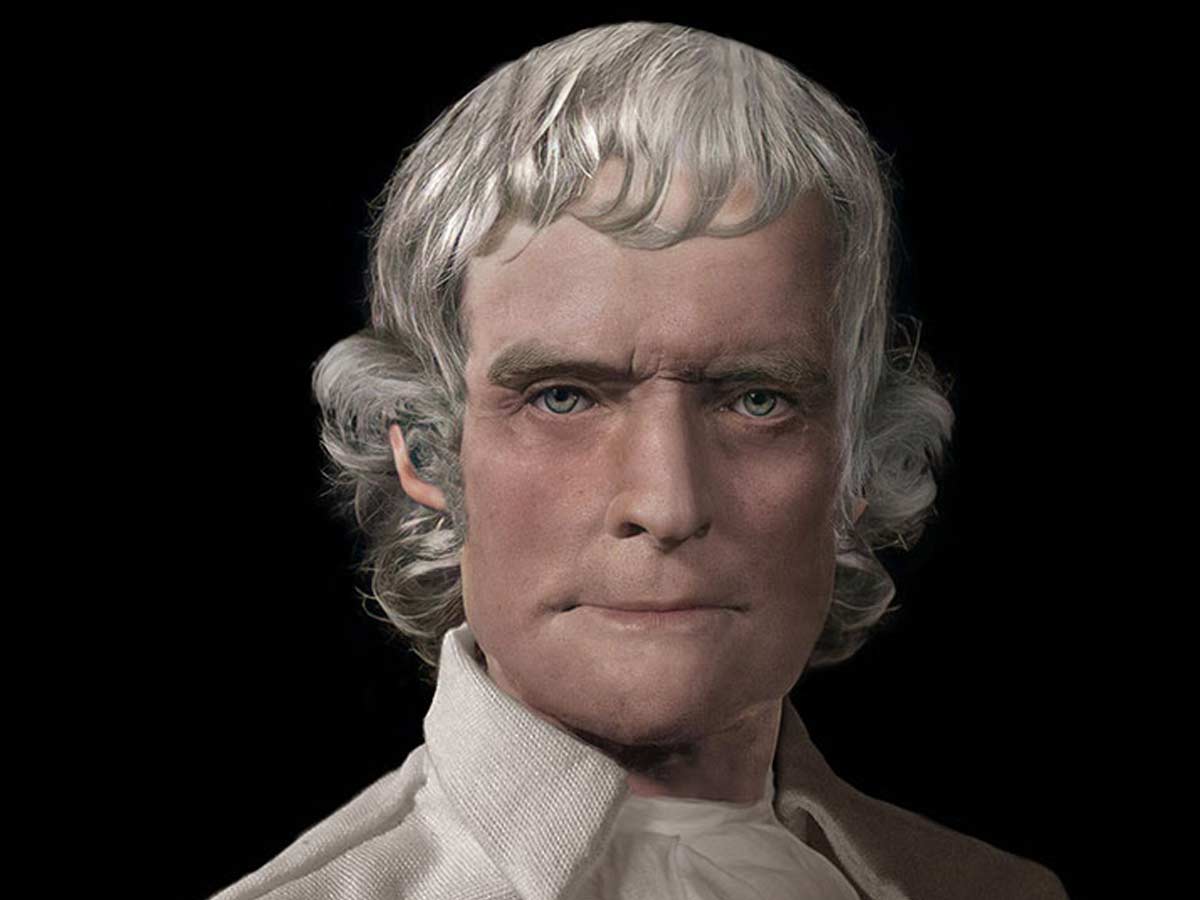
Don't get us wrong, we love the energy Daveed Diggs brings to our third president in Hamilton, but we all know it isn't what he looked like. So, if you want to look into the eyes of the Third President of the United States, take a look at this amazing artist's rendition of Thomas Jefferson. It's something else, huh?
While death masks are famous, life masks are also a thing! These are masks that were created while the person was alive, and that's how we know what Jefferson looks like. Digital Yarbs is all about showing us what our forefathers looked like. Honestly, Jefferson looks spot on (and a bit like a really angry grandpa).
Benjamin Franklin

What didn't Benjamin Franklin do during his lifetime? Calling him an overachiever just doesn't do justice. He was a great politician, the Postmaster of Philadelphia, an Ambassador to France, and a founding father of the United States of America! When he wasn't madly busy, he was working on tons of different inventions.
Franklin invented the Franklin Stove, which used less fuel than the ones used during his time. He also invented musical instruments, bifocals, and even worked on the first American political cartoons. Who knew we had comic strips back then? Basically, Benjamin Franklin couldn't be stopped even if you tried. The man was a machine.
Benjamin Franklin

Like many of our founding fathers, we're used to seeing him on a $100 bill (if you're lucky), staring at us in disapproval as we hand him over. Sorry, Ben. We also wish we could keep you in our wallets. However, what did he really look like? Turns out, pretty similar to what our history books have shown us all along!
Digital Yarbs had a chance to take Ben Franklin's life mask to show us what everyone else would have seen while they were working on the Declaration of Independence. The mask was clearly taken when he was much older, but not old enough where he would have lost all his hair. Thanks to the rendition, we can see his scowl (as present as ever) and his strong brow.
Napoleon Bonaparte

It's kind of sad that Napoleon Bonaparte is best known for being short. He was actually 5'7", which was average for a man of his time in France. Napoleon accomplished a ton of stuff and was widely considered to be one of the most exceptional military masterminds of his time.
Not only did he win many battles for France, but Napoleon also pretty much laid the foundation for modern French education by improving the country's business environment – commercial and industrial – and encouraged small businesses to grow by providing loans. Not the Napoleon we remember! Turns out he wasn't all war.
Napoleon Bonaparte

Napoleon Bonaparte wanted France to be better, stronger, and modern. All that puts a lot of years on your face, doesn't it? This recreation of the French militarist's face was created using his death mask, which means it was cast right off his face. While hard work puts wrinkles on some people's faces, not Napoleon's!
We want to know what Napoleon's skincare regimen was because he doesn't look a day over 30 in this recreation. He was actually in his early 50s when he died. He ended up dying in exile, and in the last years of his life, he was alone and depressed (a comment that his personal physician recorded).
Statue of Liberty

Few things are more recognizable than the Statue of Liberty. The massive monument is the first thing people used to see when they came to the United States. It became a symbol of freedom and democracy. Everything about her is supposed to give hope to immigrants as they seek refuge and opportunity in America.
The monument itself was given to America by the French years following the American Civil War. It was originally designed by Frederic-Auguste Bartholdi along with help from fellow Frenchman Alexander Gustave Eiffel, who designed the Eiffel Tower. It's made from copper and was originally the same color as pennies, but it oxidized over the years and turned the familiar green we know today.
Statue of Liberty

Where did her likeness come from? Well, no one knows for sure. Historians have two different ideas on where the designer, Frederic-Auguste Bartholdi, got her looks from. A large number of them believe that the monument has to be modeled after Bartholdi's mother, Charlotte Beysser Bartholdi. We can kinda see it!
Both have a very strong look about them. Bartholdi's mother also has a pointed nose similar to what we see on the Statue of Liberty. The only problem is that we don't have much to go off of to prove that it's definitively his mother. A painting doesn't really show depth like we'd need to be sure.
Statue of Liberty
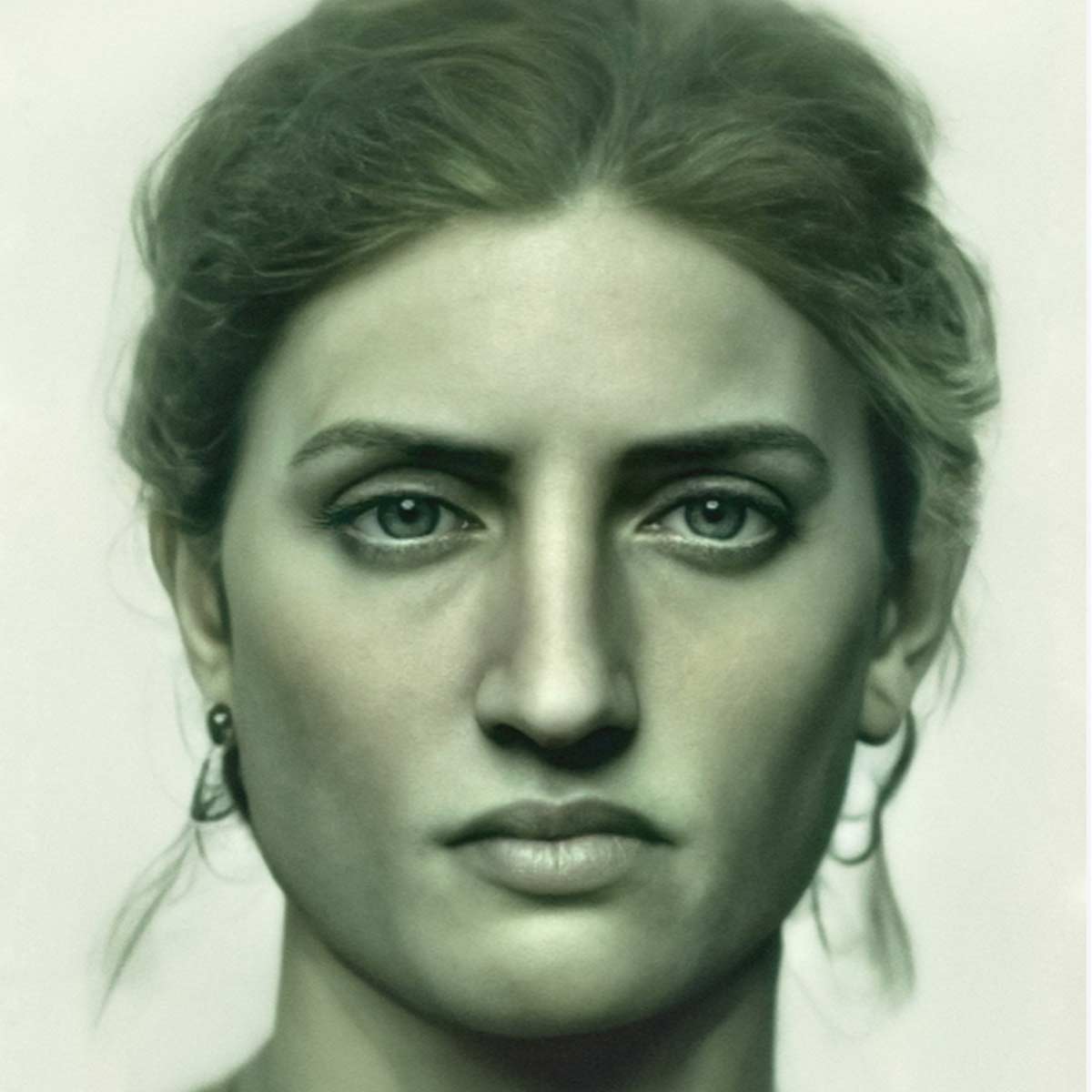
The other thought is a lot more believable and is often considered and is even backed up by history. See, Bartholdi was originally going to design the Statue of Liberty to be a woman dressed in Arab peasant garb. She was supposed to be at the southern opening of Egypt's Suez Canal. However, the ruler went bankrupt.
Because of that, the project was abandoned. Instead of scrapping the idea, Bartholdi recycled the design. He decided that he wanted to give the massive monument to the United States to celebrate the centennial of the American Revolution. The Arab garb was swapped for the outfit of the Greco-Roman goddess of liberty.
Henry VII
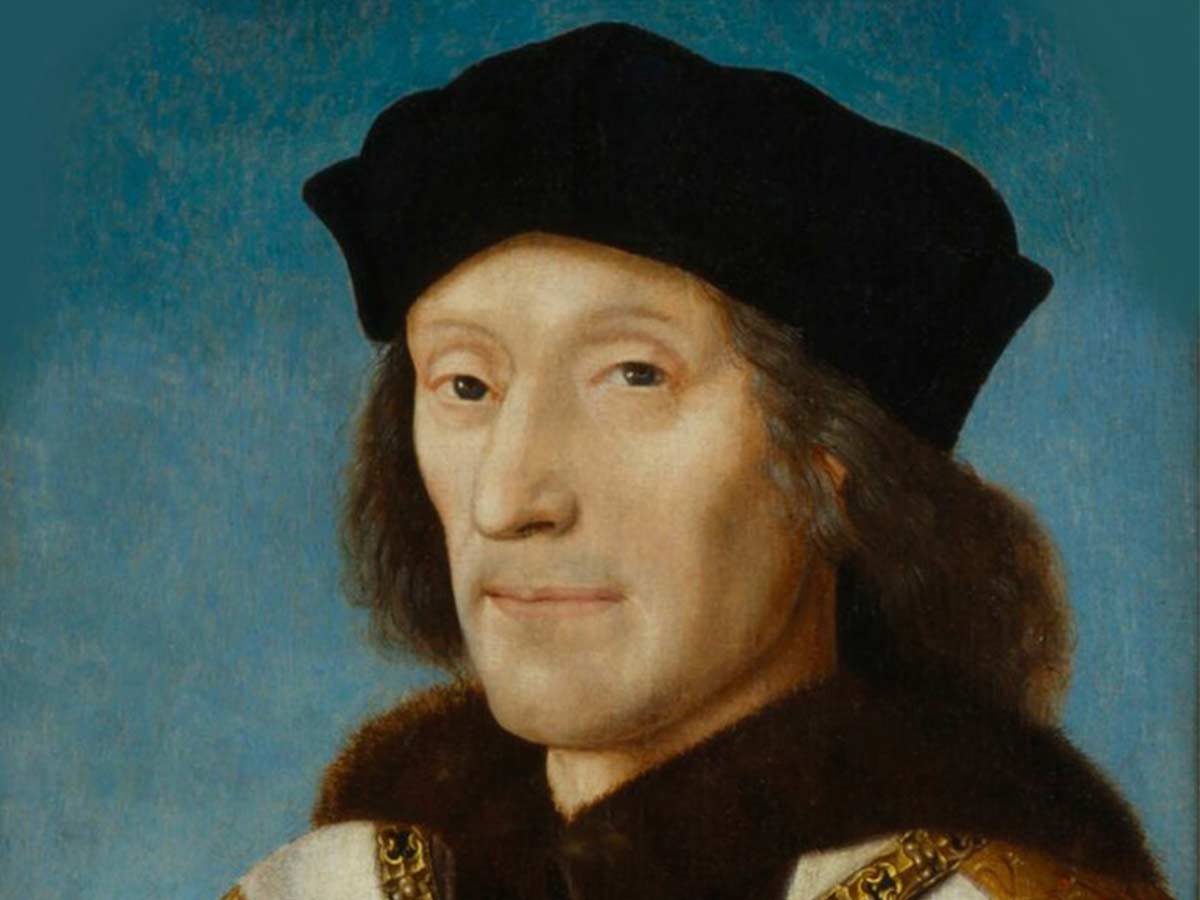
Henry VII may be less popular than his son, but it's easy to argue that he's just as famous (and much less infamous for offing his wives). Before Henry was even born, the Wars of the Roses had been raging and would for 30 years. This war was between two Tudor factions, both claiming they deserved to be the ruler of England.
Henry VII ended these rough battles after winning the Battle of Bosworth in 1485. Henry VII and his supporters cut Richard III. Rumor has it, the crown was placed on his head right there. Henry's first act? He married Elizabeth of York to unite the two feuding factions and put an end to the Wars of Roses, uniting the Tudor houses.
Henry VII

We don't exactly have a photo of Henry VII, so all we really have of his likeness are paintings and his death mask. But, thanks to determined artists, we now know what he looks like! He's much thinner than we would imagine, but that could be because he died of tuberculosis at the age of 52.
Another thing we noticed was that the artists took some…liberties with Henry VII's eye. We're not going to say that his eyes are even (because one is definitely looking up while the other is looking down), but in the artist's renditions, it's like his eyes are in different zip codes.
Robert Burns

You may not know Robert Burns by name, but we guarantee you've heard some of the stuff he's written. Robert Burns is widely regarded as the national poet of Scotland and wrote some of the biggest songs we sing every year. Anyone else remember the little ditty a ton of people belt out during New Year, "Auld Lang Syne."
While that's his most famous, he wrote several other things. One of his poems was used in The Catcher in the Rye to inspire Holden Caulfield (although the character famously misunderstood the poem, to begin with). Now, we can finally put a face to the name, and what a face it is!
Robert Burns
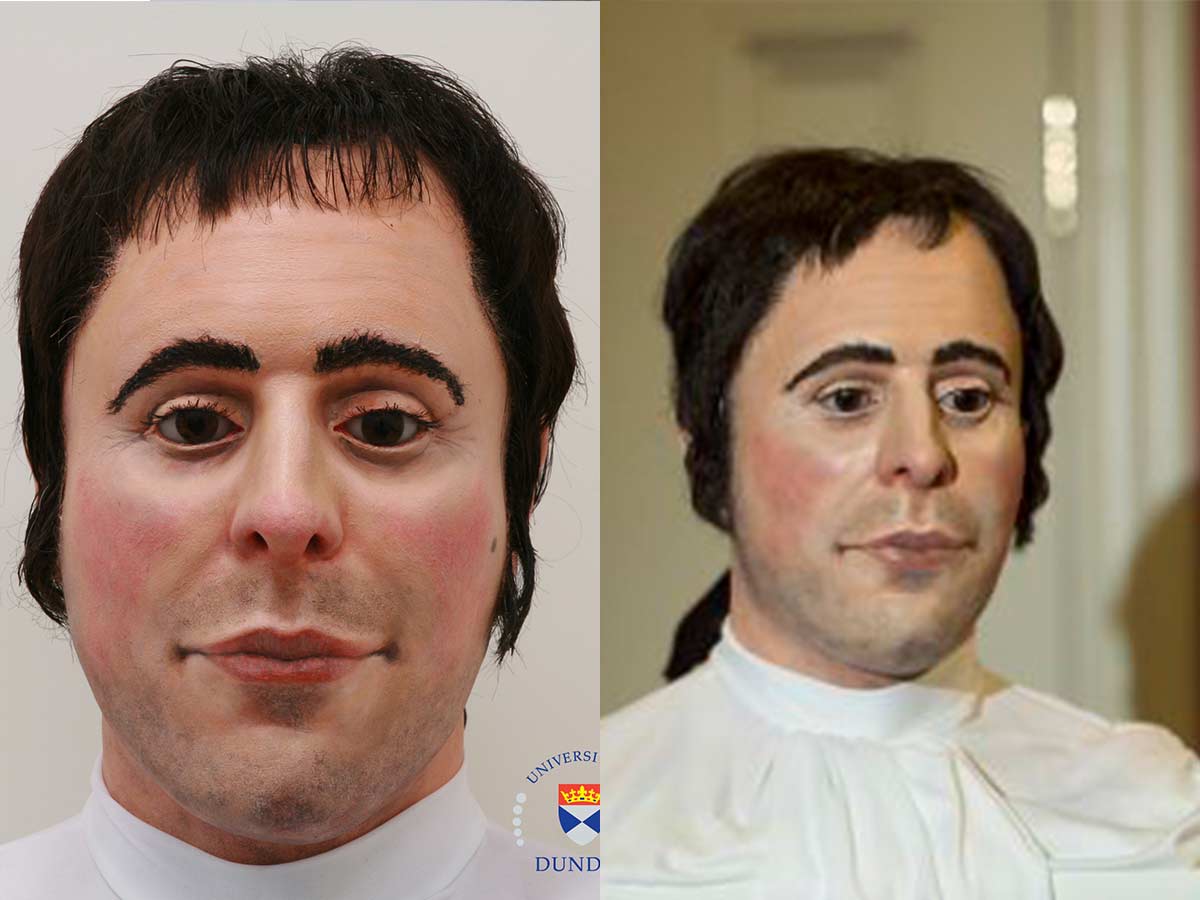
Thanks to the University of Dundee, we can see what this famous poet looks like. Forensic experts, scientists, and artists joined forces to compile what we know of Burns based on statues, art, and his skeletal remains. It definitely was a challenge for everyone involved, but we can all say that it was worth it.
Like you may expect of a poet, Burns has a sensitive face with very powerful features that certainly stand out. This goes to show that the paintings and drawings we've seen of him just didn't capture his likeness exactly – something we've seen in other hugely historical figures like queens and presidents.
David

We're not here to say that the statue of David is a real person. Michelangelo's David was based on the Biblical character and was designed to show off the artist's technical skill in the most beautiful way possible. However, plenty of people have stated that there is no other piece quite like it, and that's true.
Anyone who's been up close to David can see the painstaking detail Michelangelo took on each tiny little section from the veins in his hands to the tiniest little lines on his face. Considering David was such a prominent figure of the Renaissance and is still one of the biggest monuments today, we had to include him.
David
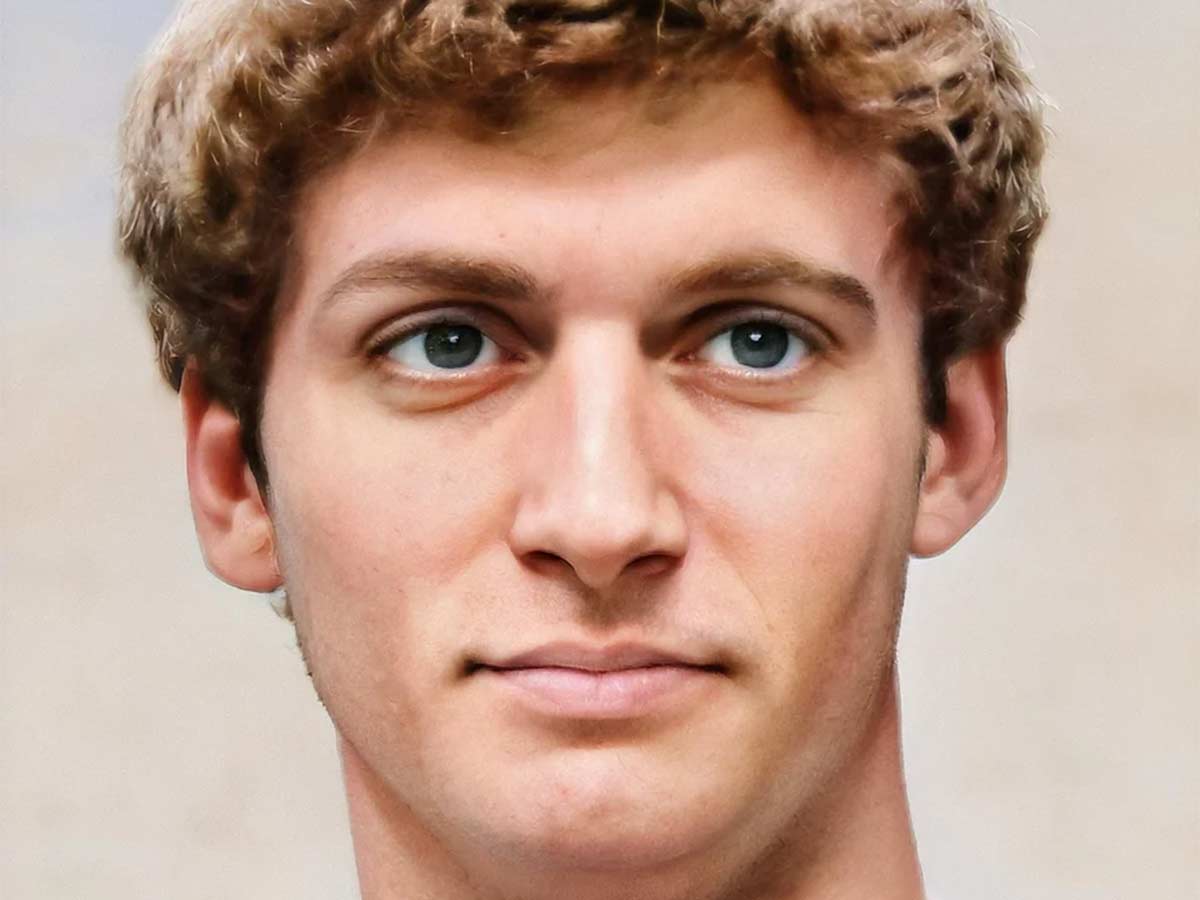
Bas Uterwijk is an extremely popular artist who takes famous historical figures in art and turns them into real people. Thanks to him, we can see what David may have looked like if he were a real person, and the semblance is staggering. For us, the most significant difference is the lifelike smile on his face.
The marble made him look stark and sharp, but the colored rendition added a boy-like charm to David. He looks almost like someone you might see walking down the sidewalk in a city, but at the same time, he is nearly too perfect to exist. Thank you, Bas, for showing us what Michelangelo's David looks like as a person!
Frederic Chopin
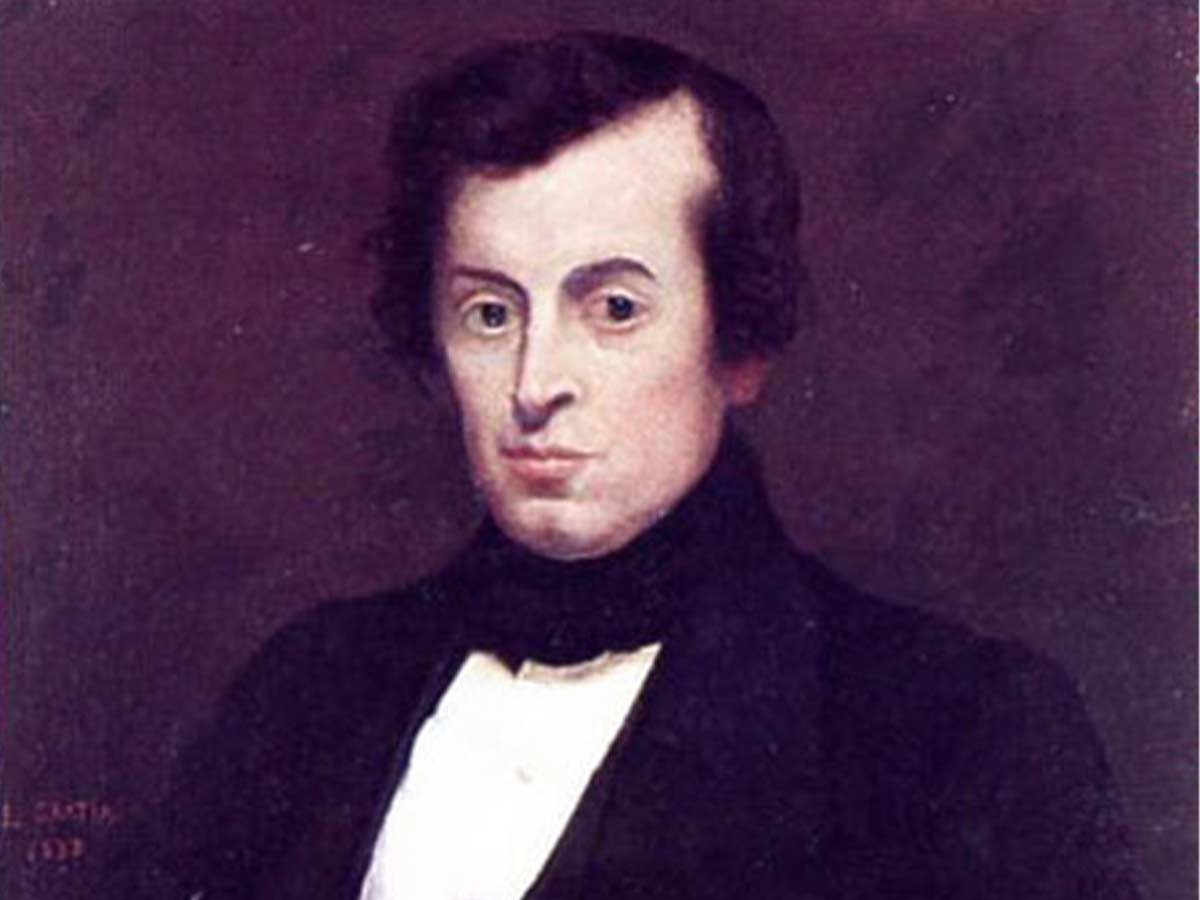
Chopin was a Polish composer that lived in the early 1800s, which means we have photos of him. The only issue is that the images are very rugged. Many have been restored, but there are still little imperfections that leave us wondering. For someone who ruled the Romantic period of music, we have to give him justice.
After all, Chopin maintained worldwide recognition centuries after his death. However, he wasn't always famous. He started out his career by selling compositions and giving piano lessons to stay afloat. As time passed, the existence of this virtuoso spread, and he gained a well-deserved reputation. Today, he's taught in schools and universities all over the world.
Frederic Chopin
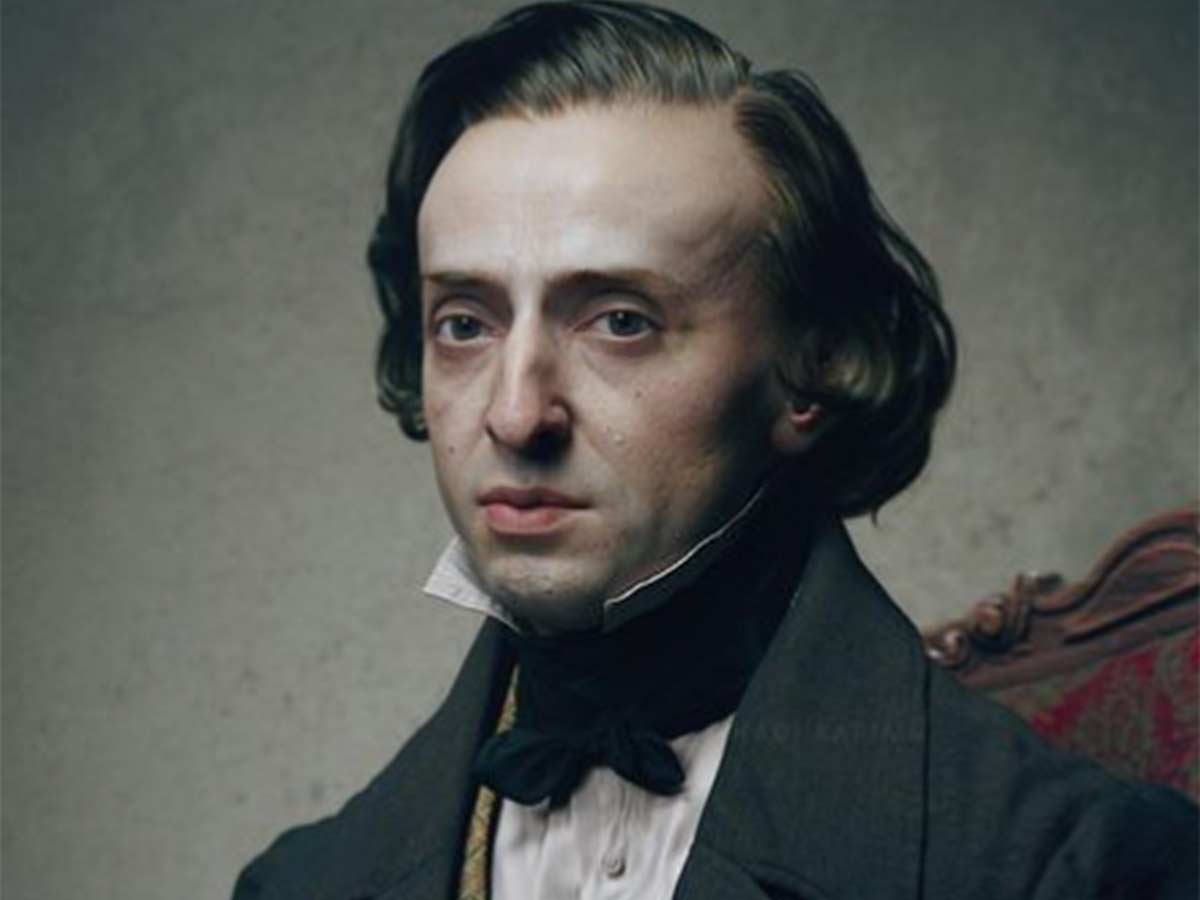
Artist Hadi Karimi wanted to give Chopin the same life he gives everyone else when we hear his pieces. He created this image that lets us see exactly what Chopin looked like. The Chopin Institute was kind enough to provide a highly detailed 3D scan of his death mask so Karimi could get as close as possible.
Still, he had to fix some areas of the face around the chin and forehead. Based on the pictures he has, this is likely exactly what you'd see if you had the chance to look Chopin in the eyes. We'll say this – the photograph didn't do his nose justice. It has the hook that was almost desired back in those days (as it denoted intelligence).
 Author
Jennifer Freehill
Last Updated: March 28, 2024
Author
Jennifer Freehill
Last Updated: March 28, 2024
